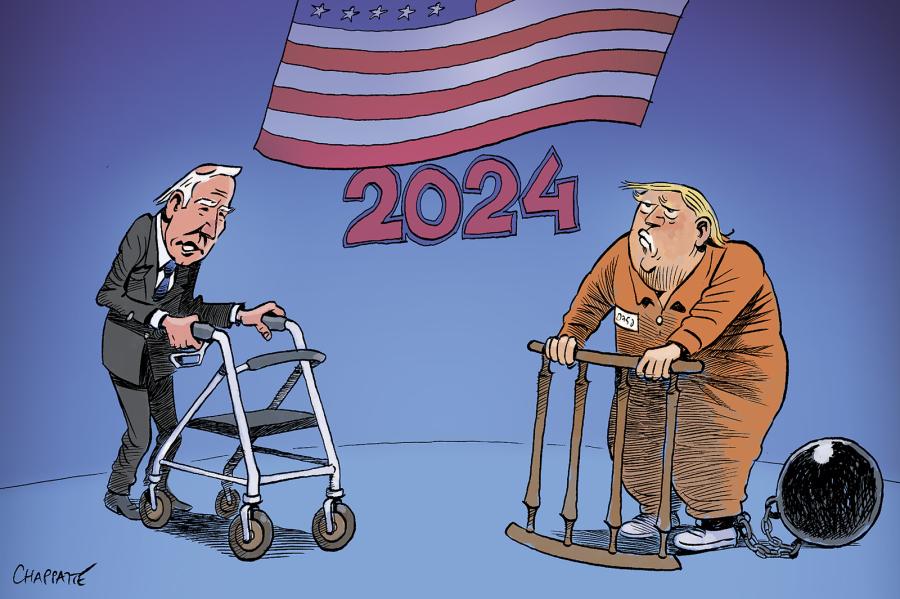Political Rhetoric And The 2024 Election: Trump And Biden's Strategies

Table of Contents
Donald Trump's Populist Rhetoric
Trump's campaign strategy relies heavily on populist rhetoric, aiming to resonate with a specific segment of the electorate. This approach involves several key components:
Nationalist Appeals and "America First"
Trump consistently employs themes of national pride, border security, and economic nationalism. His political rhetoric centers on an "America First" ideology.
- Use of strong, emotive language: Trump frequently utilizes powerful, evocative language designed to stir strong emotions in his supporters, bypassing nuanced debate.
- Emphasizes anti-establishment sentiment: The "drain the swamp" narrative continues to be a central theme, framing himself as an outsider fighting against the corrupt political establishment.
- Frequent use of social media: Direct communication via Twitter (or its successor) allows Trump to bypass traditional media filters and connect directly with his base, disseminating his message instantly and unfiltered.
Attack and Accusation Strategies
A hallmark of Trump's political communication is his willingness to launch personal attacks and make unsubstantiated claims against his opponents.
- Use of divisive language: He often employs language that creates an "us vs. them" mentality, solidifying his base and demonizing his adversaries.
- Repetition of key talking points: He consistently repeats key phrases and talking points to maximize their impact and create memorable soundbites, reinforcing his message through constant repetition.
- Exploitation of societal divisions and anxieties: Trump's rhetoric often targets and exacerbates existing societal divisions and anxieties, using them to his advantage in the political arena.
Joe Biden's Pragmatic Approach
In contrast to Trump's populist approach, Biden's campaign employs a more pragmatic and traditional strategy.
Emphasis on Unity and Bipartisanship
Biden's rhetoric emphasizes the importance of finding common ground and working across the political aisle.
- Presentation of a calm and reassuring demeanor: He projects an image of stability and experience, contrasting with Trump's more volatile style.
- Use of data and evidence: Biden frequently uses data and evidence to support his policy proposals, appealing to reason and logic.
- Appeals to national unity and shared values: He attempts to build consensus by appealing to shared American values and a sense of national unity.
Highlighting Policy Achievements and Experience
Biden's campaign highlights his extensive experience in government and his legislative accomplishments.
- Strong emphasis on concrete policy solutions: His rhetoric focuses on offering specific, detailed plans to address key issues facing the nation.
- Use of testimonials and endorsements: He frequently uses testimonials and endorsements from experts and supporters to bolster his credibility.
- Targeted communication to specific demographics: Biden's campaign employs targeted communication strategies tailored to specific demographic groups, addressing their concerns and aspirations.
Comparing and Contrasting Rhetorical Strategies
Analyzing the rhetorical strategies of Trump and Biden reveals significant differences:
Tone and Style
Trump's aggressive and confrontational style sharply contrasts with Biden's more measured and conciliatory tone. This difference in tone shapes their public image and influences how their messages are received.
Messaging Focus
Trump's messaging focuses on nationalism, anti-establishment sentiment, and personal attacks. Biden emphasizes unity, bipartisanship, and his experience. These contrasting core themes define their campaigns.
Target Audience
Trump's rhetoric targets a specific base of supporters, while Biden aims for a broader appeal, seeking to unite different factions within the electorate. This difference in target audience shapes their campaign strategies.
Impact on Media Coverage
The contrasting rhetorical styles of both candidates significantly impact media coverage. Trump's controversial statements often dominate headlines, while Biden's more measured approach receives less sensational coverage. This difference in media attention directly impacts public perception.
Conclusion
The 2024 election will likely be heavily influenced by the effectiveness of Trump and Biden's distinct rhetorical strategies. Trump's populist appeals and confrontational style stand in stark contrast to Biden's pragmatic and unifying approach. Understanding these differences is vital for voters to navigate the information landscape and make informed decisions. To further understand the impact of political rhetoric on the 2024 election, continue researching the candidates' statements and media appearances. Analyzing their campaign strategies is crucial to understanding the ever-evolving political climate.

Featured Posts
-
 Presiden Prabowo Dan Giant Sea Wall Dukungan Dpr Dan Implikasinya
May 15, 2025
Presiden Prabowo Dan Giant Sea Wall Dukungan Dpr Dan Implikasinya
May 15, 2025 -
 Discussie Leeflang Noodzaak Voor Overleg Tussen Bruins Hamer En Npo Toezicht
May 15, 2025
Discussie Leeflang Noodzaak Voor Overleg Tussen Bruins Hamer En Npo Toezicht
May 15, 2025 -
 Padres Fall To Rays In Series Sweep Post Game Analysis
May 15, 2025
Padres Fall To Rays In Series Sweep Post Game Analysis
May 15, 2025 -
 The Ultimate Guide To Creatine Benefits Risks And Usage
May 15, 2025
The Ultimate Guide To Creatine Benefits Risks And Usage
May 15, 2025 -
 Elon Musks Twitter Rename Sends Gork Meme Coin Price Skyrocketing
May 15, 2025
Elon Musks Twitter Rename Sends Gork Meme Coin Price Skyrocketing
May 15, 2025
